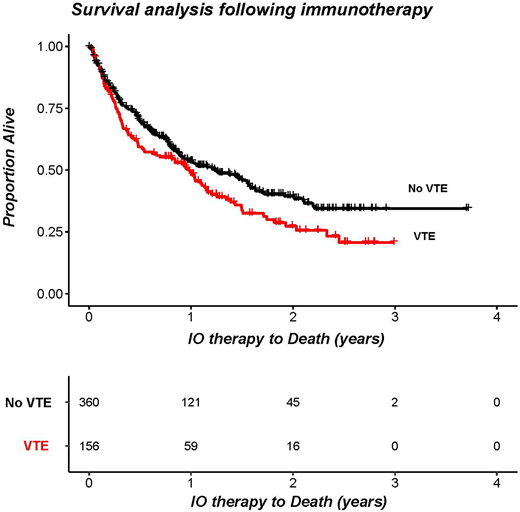Abstract
Background
Venous thromboembolism (VTE) is known to complicate several classes of anti-cancer therapies including chemotherapy and anti-angiogenic agents. Immunotherapy is a novel and growing approach to systemic treatment of cancer, but little is known about incidence or prevalence of VTE in cancer patients on immunotherapy. The objective of this study was to describe rates of VTE in cancer patients on various immunotherapy regimens.
Methods
We conducted a single institution, retrospective cohort study at Taussig Cancer Center of the Cleveland Clinic. The study was approved by the institutional review board. The study cohort was created using our center's pharmacy database of patients who received any of the six FDA approved immunotherapy agents (ipilimumab, nivolumab, pembrolizumab, atezolizumab, avelumab or durvalumab) between July 2015 and December 2017. VTE events including deep venous thrombosis (DVT) and pulmonary embolism (PE) were identified by chart review. Overall survival (OS) was estimated by the Kaplan-Meier method and evaluated for association with VTE following immunotherapy using Cox proportional hazard regression with two-sided Wald test and adjustment for age at diagnosis and presence/absence of metastases. Patients receiving combination therapies were matched 1:3 to patients receiving monotherapy based on demographic and clinical attributes including: gender, race, ethnicity, primary cancer site, age at diagnosis, and stage. The incidence of VTE following immunotherapy was compared between single and combination therapy cohorts using the Pearson chi-squared test.
Results
The study population comprised 522 patients, of whom a small majority (n=307, 58.8%) were males with a median age at cancer diagnosis of 64 years (range 10 to 91 years). The vast majority of patients (n=463, 88.7%) had metastatic disease. Lung (n= 259, 49.6%) was the most common primary site of cancer. Nivolumab was the most commonly used single drug immunotherapy (n=273, 52.3%) and nivolumab + ipilimumab was the most common multidrug regimen (n=34, 6.5%). VTE occurred in 30.3% of patients (n=158), including DVT in 34.8% (n=55), PE in 34.2% (n=54), DVT+PE in 18.4% (n=29), visceral vein thrombosis in 8.9% (n=14), DVT +PE+ visceral vein in 2.5% (n=4). Using the matched subset of patients receiving single (n=129) and combination (n=43) immunotherapies, the rate of VTE in single vs. combination immunotherapy was 36% vs. 28% (p value = 0.45). VTE in patients on immunotherapy was associated with worse survival, but this association was not statistically significant when adjusting for age and metastases [HR = 1.215, (95%CI 0.94 to 1.55) p value = 0.121].
Conclusions
VTE is common in cancer patients receiving immunotherapy either as single-agent or combination regimens, affecting nearly one-third of all patients and may potentially be associated with worsened survival. Further work is necessary to identify pathophysiology, risk factors and benefit of thromboprophylaxis in this setting.
Khorana:Janssen: Consultancy; Bayer: Consultancy; Pfizer: Consultancy; Sanofi: Consultancy.
Author notes
Asterisk with author names denotes non-ASH members.


This feature is available to Subscribers Only
Sign In or Create an Account Close Modal